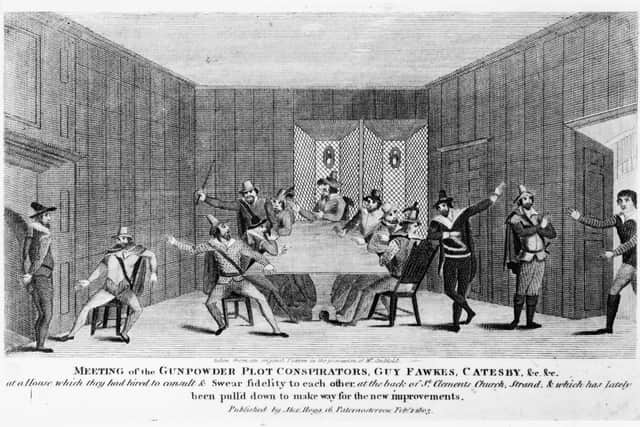Bonfire Night: the real story of Guy Fawkes and the Gunpowder plot - why do we celebrate on November 5?
and live on Freeview channel 276
The winter is well and truly on its way and as the weather turns so are a host of festivities. First, there's Halloween in late October, closely followed by Bonfire Night in early November.
The latter is also known as Guy Fawkes Night and takes place on November 5. The skies will be lit up on this day - and on surrounding days - by fireworks and bonfires across the UK - but why exactly does this take place?
Advertisement
Hide AdAdvertisement
Hide AdWell, while it is a time of celebration nowadays, that certainly wasn't the case with the origin of the annual event. In fact, the day could have gone down in history as one of Britain's darkest ever.
Guy Fawkes Night originates during a period of British history shrouded in religious persecution and political turbulence.
Who was Guy Fawkes?
Guy Fawkes was born in York in 1570. His father, Edward, was a church lawyer and prominent Protestant in the city, while his mother, Edith, was part of a family that included secret Catholics.


This denomination of Christianity had to be practised in private at the time due to persecution during the reign of Elizabeth I (1553 - 1603) - the last of the protestant Tudor dynasty. This was because many plots against Queen Elizabeth had been led by Catholics, while Britain’s enemies at the time included the Catholic countries France and Spain.
Advertisement
Hide AdAdvertisement
Hide AdWhen Fawkes was eight, his father died and his mother remarried - tying the knot with Dionysius Bainbridge. Guy Fawkes was drawn into his stepfather’s religion and converted to Catholicism.
When he was 21, Fawkes travelled to Europe to fight for Catholic Spain against Protestant Dutch reformers who were in the midst of what is now known as the Eighty Years War. After a decade of fighting, he met fellow Englishman Thomas Wintour in Spain.
At the time, Wintour was looking for people to join a group of Catholic conspirators based in England, led by his cousin Robert Catesby - an ancestor of Game of Thrones actor Kit Harington. It saw Fawkes return to England in 1604, where Protestant Scottish king James I had been crowned the previous year.
What happened in 1605 and what was the Gunpowder Plot?
In 1605, Guy Fawkes and several accomplices - including Harington's forebear Catesby - attempted to blow up the Houses of Parliament.
Advertisement
Hide AdAdvertisement
Hide AdWhen he returned to Britain in 1604, Guy Fawkes became part of the Gunpowder Plot, led by Catesby. The plan was to blow up Parliament during its state opening on 5 November, when James I, the Queen and his heir would all be in the same place.
The plan was to install King James’ daughter Elizabeth on the throne to serve as a Catholic puppet queen. There were 13 conspirators in all:
- Guy Fawkes
- Robert Catesby
- Thomas Wintour
- Robert Wintour (Thomas’ brother)
- John Grant (brother-in-law to the Wintours)
- Francis Tresham (Catesby’s second cousin)
- Thomas Bates (Tresham’s servant)
- Christopher Wright (Fawkes’ childhood friend)
- John Wright (Christopher’s brother)
- Thomas Percy (the brother-in-law of the Wrights)
- Everard Digby
- Ambrose Rookwood
- Robert Keyes
The plotters rented cellar space that extended below the Houses of Parliament. Fawkes was the only member of the group who knew anything about gunpowder - he was an explosives technician during his military days.
It is believed this was the reason why he was left in the cellar to set off the fuse for the explosives. But Fawkes was discovered before he could blow anything up.
Advertisement
Hide AdAdvertisement
Hide AdAn anonymous letter tipped off the authorities that an explosion was planned. It led to a search of the spaces in, around and underneath Parliament and the discovery of Fawkes along with 36 barrels of gunpowder - although the number of barrels is disputed.
Fawkes was questioned and then locked up in the Tower of London where he was tortured. After days of holding out, he named his co-conspirators and signed a confession.
Robert Catesby, the Wright brothers, and Thomas Percy were discovered and shot after having fled to the Midlands, while the conspirators were taken to the Tower of London. There, they were tried and then sentenced to death for treason.
On 31 January 1606, they were dragged behind a horse along the streets of London to Westminster Yard where they were hung, drawn and quartered.
Advertisement
Hide AdAdvertisement
Hide Ad

Guy Fawkes’ Legacy
Since his death, Guy Fawkes has lived on as a symbol of rebellion around the world. In part, this has been down to 2005 film ‘V for Vendetta’, in which a protagonist wearing a Guy Fawkes mask attempts to bring down a fascist dictatorship in the UK.
The mask has also become synonymous with ‘hacktivist’ group Anonymous.
Why do we celebrate Bonfire Night?
After the Gunpowder Plot was foiled, James I passed a thanksgiving act to celebrate its failure and his survival. Called the Observance of 5 November Act 1605, it involved a special church service, bonfires and fireworks. This Act remained in law until 1859.
Despite no longer being a legal requirement, celebrations have taken place ever since and often see effigies of Guy Fawkes - as well as contemporary political figures - burnt on the bonfire.
A ceremonial search for hidden explosives is still undertaken by the Yeomen of the Guard in the cellars below the Palace of Westminster.
Comment Guidelines
National World encourages reader discussion on our stories. User feedback, insights and back-and-forth exchanges add a rich layer of context to reporting. Please review our Community Guidelines before commenting.
